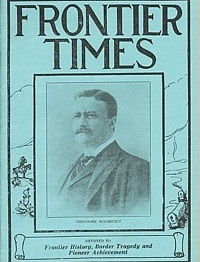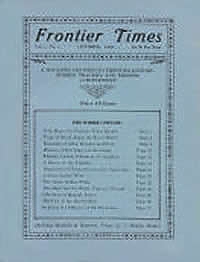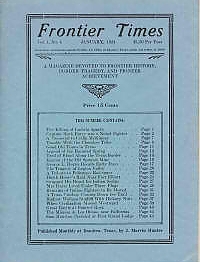By using our website, you agree to the use of cookies as described in our Cookie Policy
Magazines & Instant Downloads
Vol 08 No. 09 - June 1931
Theodore Roosevelt, Ranchman
The most picturesque episode in the remarkable career of Theodore Roosevelt was that of his life as a Ranchman in the Northwest during several years of the middle '80's. His experience on the range and elsewhere in the Great West added largely to his knowledge and to his admiration of his fellow-countrymen, and from it he drew the inspiration and obtained the material for those of his books in which he so vividly portrays scenes, tragedies, characteristics, comedies, and incidents of the cow town, the ranch, the range and the hunting trail. In 1884, after having worked through part of the season as a cowboy, Roosevelt, beginning with 500 head of cattle, established himself as a range stockman on the Little Missouri River in the western part of the State of North Dakota, but then a portion of the Territory of Dakota; his location. being north of what then was the little hamlet of Medora his nearest town on the Little Missouri, where the Northern Pacific Railroad crosses that stream, and about twenty-five miles east of the Montana line. This is an account of those formative days in the life of this great man.
Further Mentions: the North Dakota county of Billings, of 6,150 square miles, and of which Medora is; James G. Blaine; Mr. Roosevelt had two ranches near each other on the Little Missouri, one which was known as the "Elkhorn Ranch," and the other as the "Chimney Butte;" the former being his home ranch; Kildeer Mountains;
DANCING GIRL OF BILL HICKOK'S DAY, SCOFFER AT BRAVADO, DIES
Brief account of Mrs. Annie Anderson, who knew well the old Wild West of Bill Hickok's day, mingled as a dance hall girl among its cowboys and gunmen and served the frontiersman as a rooming house proprietor at Dodge City, Kansas. She relates some eye-witness accounts of notable events.
Further Mentions: Boot Hill; Bat Masterson & his famous fight on street; Peacock; O. B. Powell, superintendent of the Jacksboro Public Schools, Jacksboro, Texas;
SALE OF MINE 50 YEARS AGO REVIVED AT BRADY
A half century ago Meredith Spiller sold a manganese mine, located on the Capps ranch in Mason county. There was a stipulation, says J. L. Spiller, local groceryman, that additional sums were to be paid if silver was found in paying quantities and Mr. Spiller now plans to look into the old deed records of Mason county to determine if any other than the initial payment had been made. The mine is located in a hillside and ore from it is being trucked 22 miles to Brady now. It was worked during the world war, and now Thomas Vendetto is taking it over, putting in added machinery and s sinking the shaft below a 25 foot level thinking he will find the real ore.
Meredith Spiller has several sons in West Texas. They are: R. H. Spiller of Menard; T. J. Spiller, W. W. Spiller, J. L. Spiller, Brady; W. F. Spiller, G. A. Spiller, J. E. Spiller, Voca.-San Angelo
Some Reminiscences Of Pioneer Days
Mrs. Julia Thompson Neal, San Antonio, Texas.
In this account, Mrs. Neal provides an excellent look into life in Southwest Texas in 1850’s-80’s. She and her family settled in 1852, twelve miles south of San Antonio on the Medina River.
Further Mentions: Her uncle, Dr. Desmuke; Tom Hays; Russ and Green Storey; Goggan's Music Store; the southeast corner of Navarro and Houston streets; My teacher's name was Mrs. Thompson; Mr. Stevens; a Mr. Hewitt; a Mrs. Jackson came as our governess; a boy cousin, Fount Gayle; a creek which was called the Hondo. Some of the families who lived in the community boarded pupils who came from a distance. We boarded with Mr. Downs, which was the nearest place to the school; a settlement called the Lower Hondo; Mr. Rube Smith' was killed by the Indians; Henry Downs, the doctor's son;
COW BELL LOST IN 1869 FOUND AGAIN
Mentions: Walter Goesecke, pioneer citizen of Marble Falls; a brand, A. G., the Gieseeke brand;
Traveling In The Southwest Seventy-Five Years Ago
By Colonel M. L. Crimmins. Account of Colonel William D. Lane, U. S. Mounted Rifles, (later called the 3rd U. S. Cavalry) who was commissioned June 28th, 1848, along with his children and his wife, Lydia Spencer Lane and their 1000 mile journey from Fort McIntosh on July 16th, 1856, to join the troops at Fort Clark, at Bracketsville, and then on to New Mexico. At this time, the territory through wich they were to pass was howling wilderness and full of danger. This was thirty years before Geronimo and his Apaches were rounded up, and there were many hostile Indians in that country. The coyotes would hang around the camp and frighten the children by their melancholy howls and barks. Then again some Indians usually hung around the camp, ready to run off any stray mule or horse that got beyond rifle shot of the sentinels. This is a very engaging first-hand account of that journey.
Further Mentions: She was the daughter of Major George Blaney, U. S. Topographical Engineers, who was commissioned March 4, 1815; Colonel Kenner Garrard; Colonel Victor Stanley Foster; Major Ziba L. Drollinger; Fort McIntosh at Laredo; Fort Camp Hudson; Devil's River; Del Rio; Dead Man's Gulch; Fort Lancaster; Captain and Mrs. R. S. Granger of the 1st. U. S. Infantry; Commanche Springs near where Fort Stockton was built; Fort Davis; Fort Bliss; San Elizario and Ysleta; Fort Fillmore; Mesilla; Old Billy Grier, (Colonel William Nicholson Grier, 3rd. U. S. Calvary.); Fort Craig; San Marchal;
Crane County Named For Dr. William Carey Crane
Judge R. C. Crane, of Sweetwater, Texas
The Life Of Bigfoot Wallace(Continued from last month)
"Bigfoot" Wallace is one of the front ranking characters of Texas pioneer history. He is legendary as a soldier, settler, frontiersman and general all-around Texas character. A descendant of the great Wallace and Bruce clans of the Scotland, he carried on their zeal and nobility as a freedom-lover and a freedom-fighter. This excellent history of Wallace by John C. Duval was first published in 1870, and is therefore very close to the events that occurred in conjunction with the great man’s life. You will love reading these pages, and if you need the other 14 installments of this story, just let me know.
This installment further mentions: the English minister, Doyle; General Waddy Thompson; Puebla; Perote; Jeff Bond; Indianola; the St. Charles tavern; Buffalo-Bull Ranch, Texas;
(Continued next month)
HISTORICAL TREE AT LAGRANGE
An ancient oak tree under which the men of LaGrange four times have gathered to march away to war still stands on the courthouse square of the town… General Adrian Woll* General Kirby Smith*
HOW SLAVE BOUGHT FREEDOM FOR $1,000
Mentions: Robert Leftwich* William Goyens* Haden Edwards
Letters Of "Big Foot Wallace"
Mentions certain letters the Mrs. Nora C. Franklin McCormick, of San Antonio, Texas, received from "Big Foot Wallace," the noted frontiersman. Mrs. McCormick spent her early girlhood in San Marcos and San Antonio and found much material for newspaper stories in the romance and tragedy of early Texas days. Included in these letters is the one in which he tells of the drawing of the beans at Salado. These letters are given verbatim, without any correction in Captain Wallace's spelling. They were written some ten or twelve years before his death, while he resided on his ranch near Big Foot, Texas, a village that was named for him.
Further Mentions: Capt. Cameron* Dr. Brenham* Lyons, Rice and Fitzgerald* T. Davis, Ogden & Wallace* Thurman* Middleton* Henry Whaling* San Luis Potosi* A man by the name of Sheppard* Agua Nueva, a ranch near Saltillo* Big Springs East range of mountains runs out on West side is main Rocky Mountains* Big Spring, a big horse ranch about 20,000 head* a little town called Vanan Deer* McMahon's arm*
BOOKS RECEIVED
Mentions: Mrs. O. L. Shipman of Marfa, Texas * Captain Pat Dolan, a noted Texas Ranger* Tevis Clyde Smith of Brownwood*
The Ghost Of Camp Colorado
Robert E. Howard. On the banks of the Jim Ned River in Coleman county, central West Texas, stands a substantial ghost, built of square cut stone and sturdy timber, but just the same it is a phantom, rising on the ruins of a forgotten past. It is all that is left of the army post known as Camp Colorado in the pioneer days of Texas. This camp, one of a line of posts built in the 1850's to protect the settlers from Indian raids, had a career as brief as it was stirring. When Henry Sackett, whose name is well known in frontier annals, came to Camp Colorado in 1870, he found the post long deserted and the adobe buildings already falling into ruins. From these ruins he built a home and it is to his home and to the community school house on the site of the old post, that the term of Camp Colorado is today applied. This is a very intersting story of the history of the old Fort.
Further Mentions: Major Van Dorn* Captain Theodore O'Hara* General James B. Hood, General James P. Major, General Kirby Smith* General Fitzhugh Lee, nephew of General Robert E. Lee* Captain Sol Ross, later Governor of Texas* Peta Nocona, the last great Comanche war chief & his white wife, Cynthia Ann Parker* General James P. Ma* Henry Sackett rode with Captain Maltby's Frontier Battalion Rangers in 1874, on the path of Big Foot and Jape the Comanche* Dove Creek, in Runnels county* Henry Sackett was born in Orsett, Essexshire, England, in 1851 and came to America while a youth [seller’s note: you though L’Amour made this stuff up didn’t you!]* Miss Mary MacNamara, daughter of Captain Michael MacNamara*
Waves Lap Relics Of Texas City That Storm Killed
Mrs. Charles Riechardt. The city was Indianola and it played a great part in the early days of Texas. It rose to the rank of a great port. It traded with all the cities of the world, but finally it died in 1886 as the waves came tearing in from the gulf under the lash of a hurricane and tore the buildings to pieces. The history of Indianola is perhaps as old as the history of Texas. It is believed by some historians that the site of the later city was the one chosen by Chevalier La Salle for the site of his Fort St. Louis, founded in 1686, 200 years before the shipping city succumbed to the storm, and perhaps the first white settlement in Texas. However, it was not until Texas was an independent state that the settlement which was later to be Indianola came into being. In 1844, Prince Carl Solms of Germany, selected a site on which to land his emigrants from the fatherland. He chose the shores of Matagorda bay, and named the site which lay on the land bordering the bay, Carls Haven. It was the beginning of Indianola. Around the site of the north and northwest stretched Powderhorn bayou. The water was deep and free from sand banks and rock cliffs. Large sailboats could be steered close to the mainland without difficulty. Thousands of emigrants came. This is the legendary story of the town and it’s sad demise.
Further Mentions: the great Dibrell ranch* The Morgan steamship lines* Mayor Shea, military commander* Many of the Germans migrated to New Braunfels and Fredericksburg where Prince Solms had founded other colonies* Highland cemetery*
Life Of Pioneers Described By Lamar County Woman
Mrs. M. E. F. Mackey. This excellent article, contains some very early Lamar co. History.
An Excerpt: I was born in Henry County, Tennessee, seven miles north of Paris, May 12, 1837. I lived there with my parents, John and Elizabeth Roberson, until I was 15 years old.
Father, mother, my brother, John P. Roberson; a nephew, Levi Janes; three negro slaves and I started for Texas, Oct. 3, 1852. We got here Dec. 3. We came by the horse and wagon route. On our way several families fell in line from different States, some we knew and some were strangers, all headed for the land of paradise-Texas. By the time we got here there was quite a crowd of us. We had sone gay times on our way. We would put up our tents at night and make big log fires, and cook supper.
One night there came a snowstorm that blew our tents over, we bad a time, but that was in Arkansas.
We first stopped in Dallas county, five miles west of Trinity River. We stayed there three months at Uncle Joe Roberson's.
We went from there to Johnson county and bought 360 acres of land near the little town of Alvarado. Father built two double-log houses with hall between. They broke the land with mould-board plows, and planted a crop of corn.
Father went down South and bought 160 head of cattle and 1,000 pounds of hog-meat. People here never heard of hog meat, or milk or butter; said gardens could not be raised. They lived on beef, black coffee and cornbread. Mother raised a fine garden, and the olcl Texans went wild over vegetables.
This was a beautiful country, prairie north of us, the cross timbers south. There were no fences, no fields, only a little patch of corn once in a while. Wild flowers everywhere.
There were only five families with our crowd. There were no more settlers in twenty-five miles of us at Cedar Hill, east of us. North, south and west we never knew how far, before there were any people. There were some Indians here, but they never bothered us. Lots of wild game as deer turkeys and prairie chickens. A few bears and panthers. We lived fifty miles west of Dallas where we did our trading. We went to mill there; had our wheat and corn ground until we bought a hand steel mill.
The first time I ever saw Dallas there were only two stores, run by Jack Smith and a Mr. Gold. There was a fishing shack on the river bank. The next spring a man by the name of Crutchfield came there and built a tavern out of four-foot boards. There was not much to buy or sell those days…
…While we were gone my father had sold out and moved to Lamar county, and bought 320 acres of timber land, six miles north of Maxey. We came back here and bought 237 acres on the prairie, three miles southwest of Maxey. But there was no Maxey there then, and for some time after. We could have bought land then near Petty for 50c an acre. We did not like the sticky black mud. We paid $2.10 an acre for sandy land. We wanted near the timber. We did our trading at Pinhook, later named Paris. There were only two stores and a mill up this side of Paris. This country had begun to settle up by then quite a bit.
Further Mentions: In 1853 I married J. W. Wright. He bought 360 acres of land adjoining my father's land * brother, W. J. Roberson and family* William Whitlock and J. D. Janes and families, came from Tennessee* T. C. F. Nixon* a Mr. Moran* John Roberson* Captain Daniel's Artillery* W. R. Mackey
The Killing Of Joe Walker Near Enchanted Rock
IN 1860, at the home of my father, Captain J. M. Sims, in Lavaca county, I was married to Joseph H. Walker, of Llano county. He was young, handsome and wealthy, and I was a very young and happy bride. A short time after our marriage we moved to our home in Llano, accompanied by my married sister and her husband. After a short stay they bade us farewell and returned home. For several weeks we spent most of our time visiting the friends and relatives of my husband and looking at the country. Those tall and rocky mountains were a curiosity to me and I thought it was the roughest part of the world. The mountains all covered with cedar trees and grass, the level valleys covered with green grass and mesquite timber and dotted with cattle and horses were a beautiful sight for me and I felt then as though I would always be young and happy; but alas, how different was the stern reality that followed.
On Saturday, December 15, we started on a visit to another sister of my husband who lived some distance off, near the "Enchanted Rock." This rock encloses a large basin on the top of a huge mountain which is filled with sparkling, clear water, wherein all kind of fowls drink and bathe, and I was very anxious to see it. That evening we went about 15 miles to Legion Valley, where we had a delightful time with friends. The next morning early, a beautifully clear, but cold Sabbath morning, we continued our journey, each of us being mounted on a fine mare with fine new saddles and bridles.
We rode along the public road about 6 or 8 miles, talking and laughing as gay as we could be, we came to where the road made a long curve around a large rugged mountain., when my husband said to me "Annie, how would you like to ride the cut off." This being a pathway between two mountains intersecting the road again in about two miles. "All right, just as you think best," said I. We had, gone about half a mile, when we heard some one yelling frightfully, again and again. On looking up we saw six frightful looking men riding shabby horses and coming on slowly and still yelling. They were dressed in buck skin suits all fringed and tagged and each wore a tall cap with feathers. "Oh, Mr. Walker," said I "who are these men? Are they cowboys?" "Oh no," said he, "they are Indians." I asked him what they would do. "They will try to take our horses." he answered. By this time they began to crowd us, and Mr. Walker drew his revolver and said to me: "Annie can you run your mare?" I told him I could. "Well hold your bridle tight, for the road is rough, run around that knoll there and there is the road we left. I will hold them back until you get started. I will then run straight across and join you and we can outrun them." I made a good dash, but to no avail, for as soon as we separated the Indians began…
…After about half an hour they ceased shooting, and one of them picked up a gun, walked a few steps to a tree which forked about waist high then stooping so as to hide mode of his body he laid it in a fork and took aim at Mr. Walker. Who can imagine my horror? My feelings were indescribable. My poor husband laid his pistol on the ground and put his cold, trembling arms around my shoulders and said, "kiss me goodbye dear wife, may God protect you now, for I must go." I could not cry, nor sob, but kissed him and then took the pistol and put its muzzle to my heart. "Oh, Annie what are you going to do?" he asked. I told him that I intended to go with him in case he was killed, as he had told me the savages would carry me off if they could kill him, and I did not want to go with his murderers. "Oh my brave and true little Annie," exclaimed he, "please do not commit such a deed. Oh' God stay her hand that she may not take her own life." During this time, which was only a few seconds, everything else was perfectly quiet...
Further Mentions: Dr. Walker* Deep Creek* Tom Cox* N. G. Edwards
$4.95
‹ Back








